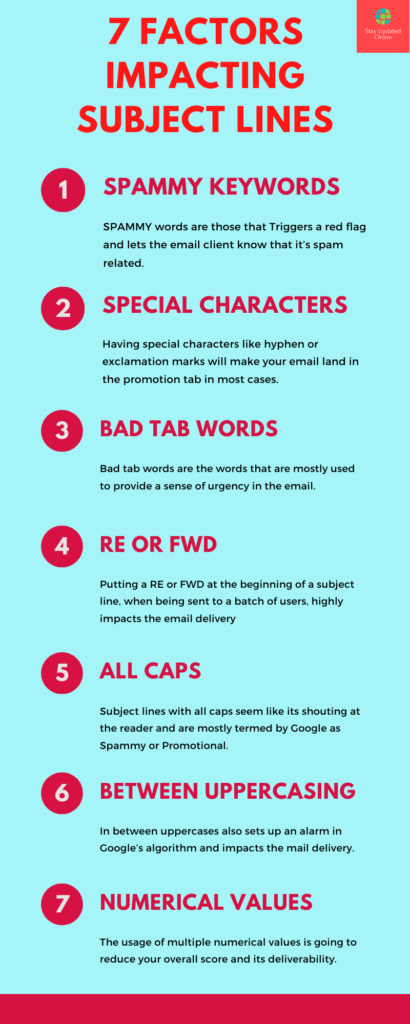Email Marketing is considered to be one of the most effective engagement channels that are being used by a Digital Marketer. On average, roughly about 300 billion emails are being sent and received each day. The average expected ROI from email marketing is somewhere around $45, for every $1 being spent. Above all, more than 80% of small companies rely just on email marketing as one of their primary acquisition tools. Hence, on looking at all of these stats, we do get a sense of how important a part it plays in a user’s product lifecycle. In the following article, we’ll be discussing the 7 email subject line good practices that impact the delivery.
Importance of Subject line in Email Marketing
There are various factors that impact the delivery of an email and the subject line of the email is one of the most crucial factors. The way you craft the subject line of an email is going to impact as to if the email is going to be delivered in the inbox or promotions or even the spam folder. Below mentioned are the crucial factors that impact the email’s subject line.
7 email subject line best practices
1. Usage of SPAMMY keywords in the subject line
SPAMMY words are those that Triggers a red flag and lets the email client know that it’s spam related. There is a huge list of spam keywords that you can avoid in your email subject lines. Click here to get the list of all these SPAMMY keywords that you can avoid in your subject line.
- Example – Get 50%
OFF on your next order
2. Usage of special characters in the subject line
Every time a special character is being made use of in the subject line, Google automatically reduces the scoring for that particular subject line impacting its overall delivery. Having special characters like hyphen or exclamation marks will make your email land in the promotion tab in most cases.
- Example – Get access to our free resources
!
3. Usage of Bad Tab words in the subject line
Bad tab words are the words that are mostly used to provide a sense of urgency in the email. However, in some cases, this might work against you as Google might recognize these words as promotional.
- Example – Register
now to get access to our exclusive resources
4. Usage of RE or FWD in the subject line
Putting a RE or FWD at the beginning of a subject line, when being sent to a batch of users, highly impacts the email delivery and in the longer run, impacts the Domain Authority of the client.
- Example –
Re: Exclusive offers on the eve of Christmas
5. Usage of all CAPS in the subject line
Subject lines with all caps seem like its shouting at the reader and are mostly termed by Google as Spammy or Promotional.
- Example – Get
FREE access to our exclusive resources.
6. In-between uppercasing in the subject line
While creating a subject line, one should keep in mind to keep the subject line as simple as possible and not to have characters uppercase in between the sentence. In between uppercases also sets up an alarm in Google’s algorithm and impacts the mail delivery.
- Example – Get access to our
Exclusive Resources
7. Multiple usages of numerical values in the subject line
Usage of numerical value does impact the subject line scoring to some extent, but again one value should be fine. However, the usage of multiple numerical values is going to reduce your overall score and its deliverability.
- Example – Get access to 7 video lessons and
5 ebooks
Conclusion
The purpose of email marketing is to make the customer feel more important, make them realize that you care and that your product serves his purpose. Hence, if you look at the steps mentioned, they are mostly aimed at how you would write a personalized email, like if you were talking to someone close to you. Therefore, by avoiding these 7 factors in the subject line, which are, usage of SPAMMY keywords, special characters, bad tab words, RE or FWD, CAPS, in-beteen uppercasing, and multiple usages of special characters, you’ll be able to improve upon the inboxing rate of your emails.
Next – Setting Google Analytics for your account
About Author

Anish
Digital Marketer, passionate about travel and adventure sports. Follow on
Facebook Profile - https://www.facebook.com/anish.sudarsan/ &
Instagram Profile - https://www.instagram.com/anishsudarsan/



